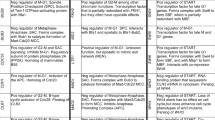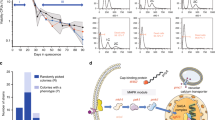Abstract
THERE is currently much interest in the mechanism which controls the timing of cell division. Certain features of the control have been found to be common to a variety of eukaryotes. In particular, the importance of cell size as a parameter affecting cell cycle progress has been reported for mammalian cells1,2 and for several single-celled eukaryotes3–6. Another feature common to several systems is that growth conditions have a direct effect on the timing of division cycle events7–9, and on cell size9,10. In the fission yeast Schizosaccharomyces pombe, both cell size6 and nutritional conditions9 have been shown to affect cycle kinetics. The organism has been used extensively as a model eukaryotic system, largely because of the ease of measuring cell size and because division occurs by binary fission11. More recently, its genetic tractability has led to the isolation of cell division cycle (cdc) mutants12, and also of wee mutants altered in the control coordinating growth with the division cycle13–15. The existence of such control mutants allows a more direct approach to the investigation of the molecular basis of division control, in contrast to the indirect methods used in other systems4,16–18. wee mutants are so far unique to S. pombe. The most conspicuous property of wee mutants is their reduced cell size13,14. Analysis of these mutants15,19 and other evidence9 has shown that control over cell division timing normally acts at entry to mitosis. As the function of a number of cdc genes is specifically required for mitosis12, interactions between wee and cdc mutants which affect mitosis might be expected. I report here that the mitotic defect caused by a defective cdc25 allele is suppressed in wee mutants. Suppression by wee1 mutants is almost complete, while the wee2.1 mutation is a less effective suppressor. The significance of these findings for genetic models of the control of mitosis is considered.
This is a preview of subscription content, access via your institution
Access options
Subscribe to this journal
Receive 51 print issues and online access
$199.00 per year
only $3.90 per issue
Buy this article
- Purchase on Springer Link
- Instant access to full article PDF
Prices may be subject to local taxes which are calculated during checkout
Similar content being viewed by others
References
Killander, D. & Zetterberg, A. Expl Cell Res. 40, 12–20 (1965).
Shields, R., Brooks, R. F., Riddle, P. N., Capellaro, D. F. & Delia, D. Cell 15, 469–474 (1978).
Prescott, D. M. Expl Cell Res. 11, 94–98 (1956).
Sudbery, P. E. & Grant, W. D. J. Cell Sci. 22, 59–65 (1976).
Johnston, G. C., Pringle, J. R. & Hartwell, L. H. Expl Cell Res. 105, 79–98 (1977).
Fantes, P. A. J. Cell Sci. 24, 51–67 (1977).
Pardee, A. B. Proc. natn. Acad. Sci. U.S.A. 71, 1286–1290 (1974).
Hartwell, L. H. & Unger, M. W. J. Cell Biol. 75, 422–435 (1977).
Fantes, P. & Nurse, P. Expl Cell. Res. 107, 377–386 (1977).
Johnston, G. C., Ehrhardt, C. W., Lorincz, A. & Carter, B. L. A. J. Bact. 137, 1–5 (1979).
Mitchinson, J. M. in Methods in Cell Physiology Vol. 4 (ed. Prescott, D. M.) 131–165 (Academic, New York, 1970).
Nurse, P., Thuriaux, P. & Nasmyth, K. Molec. gen. Genet. 146, 167–178 (1976).
Nurse, P. Nature 256, 547–551 (1975).
Thuriaux, P., Nurse, P. & Carter, B. Molec. gen. Genet. 161, 215–220 (1978).
Nurse, P. Biochem. Soc. Trans. 5, 1191–1193 (1977).
Zeuthen, E. & Rasmussen, L. in Research in Protozoology Vol. 4 (ed. Chen, T. T.) 11–145 (Pergamon, Oxford, 1971).
Sachsenmaier, W., Remy, U. & Plattner-Schobel, R. Expl Cell. Res. 73, 41–48 (1972).
Wille, J. J., Scheffey, C. & Kauffman, S. A. J. Cell Sci. 27, 91–104 (1977).
Fantes, P. A. & Nurse, P. Expl Cell. Res. 115, 317–329 (1978).
Nasmyth, K. thesis, Univ. Edinburgh (1977).
Author information
Authors and Affiliations
Rights and permissions
About this article
Cite this article
FANTES, P. Epistatic gene interactions in the control of division in fission yeast. Nature 279, 428–430 (1979). https://doi.org/10.1038/279428a0
Received:
Accepted:
Published:
Issue Date:
DOI: https://doi.org/10.1038/279428a0
This article is cited by
-
Pomegranate: 2D segmentation and 3D reconstruction for fission yeast and other radially symmetric cells
Scientific Reports (2020)
-
Shugoshin forms a specialized chromatin domain at subtelomeres that regulates transcription and replication timing
Nature Communications (2016)
-
The fission yeast DNA structure checkpoint protein Rad26ATRIP/LCD1/UVSD accumulates in the cytoplasm following microtubule destabilization
BMC Cell Biology (2006)
-
Genome-wide characterization of fission yeast DNA replication origins
The EMBO Journal (2006)
-
Mitosis-specific phosphorylation of gar2, a fission yeast nucleolar protein structurally related to nucleolin
Chromosoma (1997)
Comments
By submitting a comment you agree to abide by our Terms and Community Guidelines. If you find something abusive or that does not comply with our terms or guidelines please flag it as inappropriate.



